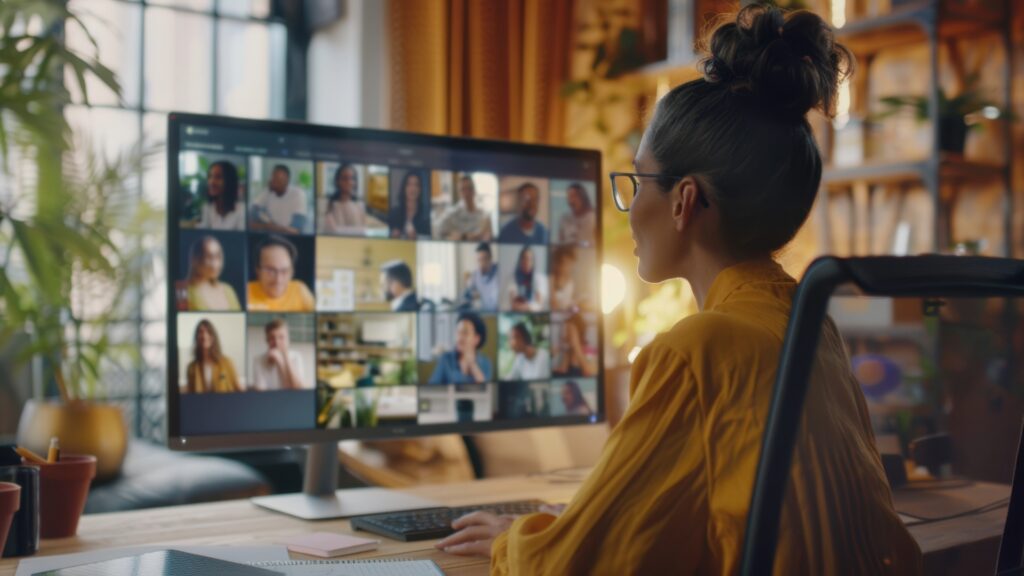Hey there, B2B marketers. Imagine if you could sidestep those pesky gatekeepers—yes, those digital bouncers—and get straight to the decision-makers without breaking a sweat. Welcome to a world where paid ads and Generative Engine Optimization (GEO) join forces to transform your digital marketing strategy. In this guide, we’re going to dive deep into the realm of advertising in B2B, reveal how paid search advertising (including LinkedIn Ads, banner ads, and text ads) can be leveraged to directly reach your target audience, and explain how GEO can significantly boost source visibility on AI-driven search engines. Prepare to harness data-driven insights, optimize your digital content, and ultimately capture those high-value leads.
Key Takeaways
Discover how to bypass administrative gatekeepers and reach business decision-makers using tailored paid ad campaigns and GEO.
Learn actionable strategies for integrating LinkedIn Ads, paid search advertising, and other ad types to capture decision-makers’ emails and cell phone numbers.
Optimize your digital content with structured data, schema markup, and authoritative style adjustments to improve content visibility in AI-driven search results.
Combine data collection, keyword research, and digital marketing strategy to leverage social media platforms and interactive elements for maximum engagement.
The Gatekeeper Conundrum: Why Traditional B2B Marketing Needs an Upgrade
Let’s face it: in B2B advertising, getting through to a decision-maker is like trying to get past a fortress guarded by an army of gatekeepers. These gatekeepers might be administrative assistants, junior managers, or even outdated systems that filter out “irrelevant” pitches. The traditional approach to search engine optimization (SEO) or even good ol’ cold calling doesn’t always cut it. Nowadays, if you want your message to reach the top brass, you need to employ a strategy that’s as clever as it is direct.
Gone are the days when merely ranking high in search engine results was enough. With the rise of AI-driven search engines like ChatGPT, Perplexity, Google Gemini, and Claude, your digital content now competes in a world where generative AI engines are the new arbiters of information. This is where Generative Engine Optimization—affectionately known as GEO—comes into play. GEO isn’t just a trendy buzzword; it’s a fundamental shift in digital marketing strategy that can help you optimize your digital content for these generative AI engines, ensuring that your information is the one they cite. In other words, you can finally give those gatekeepers the boot and get your message right into the inbox of a busy executive.
Imagine bypassing the gatekeepers with a finely tuned ad campaign on LinkedIn Ads or Google Ads, and then reinforcing your message with GEO-optimized content that AI-driven search engines love. With this two-pronged approach, you’re not only investing in paid advertising but also in a digital marketing strategy that prioritizes data collection, relevant keywords, and actionable insights. And trust me, when your content is as tailored and optimized as this, it practically leaps into the spotlight.

The Power of Paid Ads: Your Direct Line to Decision Makers
Paid advertising in B2B isn’t just a way to get noticed—it’s a ticket to targeting the very people who have the power to say “yes.” Whether you’re using paid search advertising, banner ads, or text ads, these digital marketing strategies are designed to reach your target audience with surgical precision. And let’s be honest: when you’re talking about advertising in B2B, you need to leverage every tool in your digital marketing arsenal.
Precision Targeting with LinkedIn Ads
B2B advertising involves promoting products or services to businesses and organizations, rather than individual consumers. This type of advertising is critical for businesses that rely on other businesses as their primary customers. By targeting the right audience with the right message, B2B advertisers can generate leads, build brand awareness, and drive sales.
Diversifying Your Ad Types
Beyond LinkedIn, consider how other paid ad formats can bolster your strategy:
Text Ads: These are the bread and butter of paid search advertising. By optimizing your text ads with relevant keywords, you can capture the attention of potential customers right when they’re searching for solutions.
Banner Ads: Use eye-catching visual and interactive elements in your banner ads to boost engagement. These ads should be designed to not only grab attention but also provide context and direct users to your GEO-optimized landing pages.
Native Ads: Blend your message seamlessly into professional content streams, making it less intrusive and more persuasive.
Each of these ad types is a critical component of a comprehensive B2B advertising strategy. The key is to integrate them so that your digital marketing strategy doesn’t just rely on one channel but leverages a combination of paid ads and organic tactics.
Maximizing ROI Through Data-Driven Insights
When you invest in paid ads, every cent of your ad spend counts. Conduct rigorous keyword research and continuously monitor your ad campaigns using analytics tools. This ensures that your digital marketing strategy is refined over time based on data collection and performance metrics. Look for improvements in click-through rates (CTR), conversion rates, and engagement metrics to gauge the effectiveness of your ad campaigns.
Remember, the goal is to boost your content’s visibility and reach, and ultimately to drive qualified leads—whether through paid ads or via GEO-optimized content. Integrating these strategies means you’re not only targeting the right audience but also ensuring that your message is compelling enough to bypass any gatekeepers.
GEO: Generative Engine Optimization—Your New Digital Superpower

Generative Engine Optimization, or GEO, is the next frontier in digital marketing. With the rise of generative AI engines that churn out detailed, conversational answers, traditional SEO strategies are no longer enough. GEO is about optimizing your digital content so that it becomes the go-to source for AI-driven search engines. In an age where AI-driven search engines are transforming how information is retrieved, you need to ensure your content isn’t just visible—it needs to be cited and trusted.
What Is GEO and How Does It Work?
GEO focuses on making your digital content appealing to AI algorithms. These generative AI engines, like ChatGPT, Perplexity, and Google Gemini, rely on large language models (LLMs) to synthesize information and generate direct answers to user queries. GEO is the process of refining your digital content so that it’s easily indexed, structured, and ultimately cited by these AI-driven systems.
Key aspects of GEO include:
Structured Data and Schema Markup: Incorporate schema markup into your content to help AI understand the context and provide detailed answers. This means using FAQ schemas, HowTo schemas, and Article schemas to ensure your content is easily indexable.
Authoritative Style Adjustments: Write in an authoritative tone that’s both engaging and credible. Use reputable sources, expert quotes, and detailed data to build trust with both human readers and AI algorithms.
Relevant Keywords and User Intent: Optimize your content with specific, relevant keywords that reflect the natural, conversational queries users are likely to ask. Focus on user intent rather than mere keyword stuffing.
Visual and Interactive Elements: Enhance your digital content with high-quality visuals, interactive elements, and infographics. These not only boost engagement but also help generative AI engines better parse and cite your content.
Data-Driven Insights and Continuous Optimization: Monitor your GEO performance using analytics tools and adjust your content strategy based on actionable insights. This iterative process ensures your content remains current and effective.
Why GEO Matters in B2B Advertising
For B2B marketers, GEO is a game-changer. It’s not just about getting your site to rank high in traditional search engine results; it’s about ensuring that your digital content is the one that generative AI engines choose to cite in their answers. This has a massive impact on source visibility and brand authority.
Consider this: your potential customers might never click through to your website because they’re getting all the answers they need directly from an AI assistant. But that doesn’t mean they’re not influenced by your brand. GEO ensures that when a decision-maker asks an AI-driven search engine a question relevant to your industry, your content is front and center.
By combining GEO with paid ads, you create a dual approach that not only drives immediate traffic through targeted ad campaigns but also builds long-term visibility through optimized digital content. This synergy can significantly boost source visibility, making your brand a trusted authority and ultimately capturing the leads that matter—emails, cell phone numbers, and all.

Integrating Paid Ads and GEO: A Dual Strategy for B2B Success
Let’s break down how you can combine the power of paid ads with GEO tactics to bypass gatekeepers and reach decision-makers head-on.
Step 1: Research and Planning
Before you launch any campaign, you need a solid foundation:
Keyword Research and User Intent Analysis: Use tools like SEMrush, Ahrefs, and HubSpot to conduct thorough keyword research. Identify the relevant keywords and conversational queries your target audience is using. Remember, your goal is to optimize for both traditional search engine results and AI-driven responses.
Competitive Analysis: Evaluate how your competitors are performing in both paid advertising and GEO. Identify gaps in their strategies and look for opportunities to differentiate your approach.
Define Clear Objectives: Establish what success looks like—whether it’s increased engagement from decision-makers, higher conversion rates, or more qualified leads with direct contact details. Set measurable KPIs to track progress.
Step 2: Crafting Content That Resonates
High-quality content is the backbone of both GEO and effective B2B advertising. It’s not enough to simply throw a bunch of relevant keywords into an article—you need to create content that answers detailed questions and provides actionable insights.
Develop Comprehensive Guides: Create in-depth articles and case studies that address common challenges in your industry. Use detailed answers, relevant keywords, and structured data to ensure that generative AI engines can easily index and reference your content.
Incorporate Visual and Interactive Elements: Use high-quality visuals, infographics, and interactive elements to boost engagement. These elements not only make your content more appealing to human readers but also help generative AI engines parse and extract key data.
Implement Schema Markup: Use schema markup to provide context and structure to your content. This is critical for ensuring that AI-driven search engines understand the full breadth of your digital content.
Authoritative Style Adjustments: Write in a professional yet conversational tone that is both witty and authoritative. Use reputable sources, expert quotes, and precise data to build credibility with your target audience and AI algorithms.
Step 3: Launching Targeted Paid Ad Campaigns
Now that you have your high-quality, GEO-optimized content in place, it’s time to amplify your reach with targeted paid ad campaigns:
LinkedIn Ads: Leverage LinkedIn Ads to directly target decision-makers by job title, industry, and company size. Use data-driven insights to craft ad copy that speaks directly to your target audience and bypasses administrative gatekeepers. Emphasize the unique benefits of your services and include clear calls-to-action that direct users to your GEO-optimized landing pages.
Google Ads and Text Ads: Use paid search advertising to capture users who are actively searching for solutions related to your products or services. Optimize your text ads with relevant keywords and ensure they link to landing pages that are both SEO-friendly and GEO-optimized.
Display and Banner Ads: Create visually engaging banner ads that incorporate interactive elements. These ads should be designed to capture attention quickly, using high-quality visuals and a clear message that resonates with your target audience.
Retargeting Campaigns: Implement retargeting strategies to re-engage visitors who didn’t convert on their first visit. Use personalized follow-up strategies and email marketing to nurture these leads, ensuring you capture key contact details such as emails and cell phone numbers.
Step 4: Aligning Landing Pages with GEO
Your paid ad campaigns are only as effective as the landing pages they lead to. Here’s how to ensure your landing pages are GEO-optimized:
Optimized Content: Ensure your landing pages feature GEO-optimized content that is structured with clear headings, bullet points, and concise summaries. The content should be written with relevant keywords that address user intent and provide detailed answers.
Lead Capture Forms: Integrate lead capture forms that are easy to fill out and ask for essential details—especially decision-makers’ email addresses and cell phone numbers. Use interactive elements and clear calls-to-action to encourage conversions.
Technical SEO: Make sure your landing pages are fast-loading, mobile-friendly, and fully indexed. Use schema markup to help AI-driven search engines understand your content, and ensure that your pages are accessible to AI crawlers.
Consistency in Messaging: Ensure that the messaging in your paid ads aligns with the content on your landing pages. This consistency reinforces your brand’s authority and improves the likelihood that both human readers and AI engines will engage with your content.
Step 5: Monitoring, Measuring, and Iterating
Success in B2B advertising and GEO is not a set-it-and-forget-it strategy. Continuous monitoring and optimization are key:
Analytics and Data Collection: Use analytics tools like Google Analytics, SEMrush, and specialized AI Traffic Analytics platforms to track performance. Monitor key metrics such as click-through rates, conversion rates, referral traffic, and AI citation frequency.
A/B Testing: Regularly run A/B tests on your ad creatives and landing pages to identify what drives the highest engagement and conversion rates. Test different messaging, visuals, and call-to-action formats.
Data-Driven Insights: Analyze the data collected to understand which strategies are working and which need adjustment. Use these insights to refine your SEO strategy, ad spend, and overall marketing efforts.
Adaptation and Continuous Improvement: The landscape of digital marketing is ever-changing, especially with the rapid evolution of generative AI engines. Stay updated on industry trends, experiment with new tactics, and be prepared to iterate on your strategy regularly. This adaptive approach ensures your business remains competitive and continues to bypass gatekeepers effectively.

Leveraging LinkedIn Ads: The B2B Marketer’s Secret Weapon
LinkedIn Ads are the crown jewel for B2B advertising, offering unparalleled precision targeting. If your goal is to reach decision-makers, your best bet is to utilize LinkedIn Ads as part of your paid advertising strategy. Let’s dive into why LinkedIn Ads are indispensable and how you can maximize their impact.
Why LinkedIn Ads Work Wonders
Precision Targeting:
LinkedIn Ads allow you to target specific job titles, industries, and even individual companies. This level of targeting ensures that your ads reach the exact audience you want, bypassing gatekeepers with surgical precision.Professional Environment:
The platform is tailored for business professionals. This means that your digital marketing strategy, when executed on LinkedIn, is already speaking the language of business. From paid search advertising to native ads, every piece of content can be crafted to resonate with decision-makers.High Engagement Rates:
Compared to other social media platforms, LinkedIn consistently delivers higher engagement rates for B2B campaigns. The professional context means that users are more likely to interact with content that speaks directly to their business needs.Seamless Integration with GEO:
When your LinkedIn ad campaigns lead to GEO-optimized landing pages, you create a cohesive user journey. This synergy significantly boosts content visibility in AI-driven search engines and helps capture valuable leads.
Best Practices for LinkedIn Ads
Craft Compelling Ad Copy:
Use a mix of humor, authority, and clarity in your ad copy. Highlight the tangible benefits of your product or service and include a clear call-to-action that directs decision-makers to your optimized landing page.Utilize Visual and Interactive Elements:
Incorporate high-quality visuals and interactive elements in your ads. Whether it’s a short video, a well-designed banner ad, or an infographic, these elements help capture attention and convey your message more effectively.A/B Testing:
Run A/B tests on your ad creatives and targeting parameters. Use data-driven insights to determine which versions of your ads drive the highest click-through rates and conversions. Continually optimize your ad spend based on these results.Monitor and Refine Targeting:
Regularly update your targeting criteria to reflect the evolving needs and demographics of your target audience. This ensures that your ad campaigns remain effective and reach the right people at the right time.

Technical SEO and Structured Data: The Backbone of GEO
No digital marketing strategy is complete without a robust technical SEO foundation. When it comes to Generative Engine Optimization, technical optimization is not just about speeding up your site or improving user experience—it’s about ensuring that AI-driven search engines can effortlessly index and reference your content.
Key Technical SEO Practices for GEO
Schema Markup:
Implement schema markup (FAQ, HowTo, Article) to provide explicit context to search engines and generative AI engines. This structured data helps AI understand your digital content and boosts its visibility in AI-generated answers.Page Speed and Mobile Optimization:
Fast-loading, mobile-friendly pages are essential. Use tools like Google PageSpeed Insights to optimize your site’s performance. A site that loads quickly not only enhances user experience but also signals to AI-driven search engines that your content is reliable and accessible.Clear HTML Structure:
Maintain a logical HTML hierarchy with proper use of H1, H2, and H3 tags. A clean structure ensures that your content is easy to parse for both human readers and AI models. Incorporate interactive elements and visual content in a way that’s easy to index.XML Sitemaps and Crawlability:
Regularly update your XML sitemaps to help search engines and AI crawlers discover new content. Ensure your robots.txt file doesn’t block important pages or AI crawlers like GPTBot or Bingbot.Consistent Updates:
Keep your content fresh and up-to-date. AI-driven search engines favor content that is current and provides detailed answers. Regular updates ensure that your digital content remains relevant and continues to rank well in AI-generated responses.
By investing in technical SEO and structured data, you’re not only optimizing for traditional search engines but also ensuring that your content is perfectly primed for AI-driven platforms. This dual approach significantly boosts your overall digital marketing strategy and improves content visibility across all channels.
Creating Engaging Content That Appeals to Both Humans and AI
At the heart of every successful digital marketing campaign is high-quality content. But in today’s digital age, content must not only resonate with human readers—it must also be optimized for generative AI engines. Whether it’s through email marketing, social media posts, or long-form articles, your content needs to provide detailed answers, incorporate visual and interactive elements, and use relevant keywords naturally.
Elements of Content That Bypass Gatekeepers
Answer-First Approach:
Lead with a concise, direct answer that immediately addresses the query. This “TL;DR” section is critical, as it might be the piece of content that an AI-driven search engine cites in its generated response. For example, if your content is about improving digital marketing efforts, start with a brief overview that provides a clear, actionable tip.Data-Driven Insights:
Incorporate statistics, expert quotes, and reputable sources into your content. Use data collection to bolster your arguments and present actionable insights that help your target audience make informed decisions. This not only enhances your SEO strategy but also increases the likelihood that generative AI engines will select your content as a trusted source.Interactive and Visual Elements:
Use high-quality visuals, infographics, and even video ads to illustrate your points. These visual elements can significantly boost engagement and help AI-driven search engines index your content more effectively. Incorporate interactive elements that guide the user through your key strategies, making your content more digestible and appealing.Tailored and Conversational Tone:
Write in a tone that is both professional and engaging—like a conversation with a savvy business colleague. Avoid jargon unless absolutely necessary, and focus on delivering detailed answers that reflect genuine expertise. By leveraging social media platforms and email marketing best practices, you can create content that resonates with both human readers and AI-driven search engines.Consistency in Messaging:
Ensure that your digital content maintains a consistent voice and message across all channels. This consistency not only improves brand recognition but also helps generative AI engines to index your content more effectively, significantly boosting source visibility.
By creating content that combines these elements, you can significantly boost engagement and improve your chances of being cited by AI search engines. This is where Generative Engine Optimization really shines—it’s all about making your content so good that it naturally bypasses gatekeepers and lands directly in the hands (or inboxes) of decision-makers.

Practical Implementation: Actionable Strategies and Key Factors
Now that we’ve covered the theory, let’s break down some actionable strategies that integrate paid ads and GEO to bypass gatekeepers and reach decision-makers effectively.
Actionable Strategy 1: Conduct Thorough Keyword Research and User Intent Analysis
Before you create any content or launch ad campaigns, invest time in keyword research. This isn’t just about finding the most popular search terms—it’s about understanding the intent behind those searches.
Identify Conversational Queries:
Use advanced tools for keyword research (like SEMrush or Ahrefs) to identify not only relevant keywords but also conversational queries that your target audience uses. Focus on long-tail keywords that are more specific and reflective of user intent.Analyze Competitor Strategies:
Examine how your competitors are performing. Look at what keywords they are ranking for and identify gaps in their strategies that you can leverage. This will help refine your SEO strategy and GEO optimization efforts.Leverage Social Media and Forums:
Platforms like LinkedIn, Reddit, and industry-specific forums are treasure troves of conversational queries. Use these insights to craft content that answers questions directly, increasing your chance of being cited in AI-generated responses.
Actionable Strategy 2: Develop GEO-Optimized Content
Creating content for generative AI engines requires a unique approach. Here’s how to do it right:
Craft Detailed, Actionable Content:
Write comprehensive guides, case studies, and articles that provide detailed answers to specific queries. Incorporate relevant keywords naturally, and include structured data through schema markup to make it easy for AI to index your content.Use Visual and Interactive Elements:
Incorporate high-quality visuals such as infographics and interactive elements like embedded videos or dynamic charts. These elements not only boost engagement but also help generative AI engines understand and cite your content more accurately.Optimize for Readability and Clarity:
Break up your content with clear headings, bullet points, and short paragraphs. This improves readability for human readers and makes it easier for AI algorithms to extract key information.Include Reputable Sources and Data:
Strengthen your content by citing reputable sources, incorporating expert quotes, and including relevant data. These authoritative signals are essential for GEO and increase your content’s credibility.
Actionable Strategy 3: Launch and Optimize Targeted Paid Ad Campaigns
Paid ads are your direct line to decision-makers. When executed correctly, they help bypass gatekeepers and drive high-quality leads directly to your GEO-optimized landing pages.
Design High-Converting LinkedIn Ads:
Use LinkedIn Ads to target decision-makers by job title and industry. Create ad campaigns that are witty yet professional, and ensure your ad copy highlights the value your business provides. Utilize A/B testing to refine your messaging and optimize ad spend.Utilize Google and Text Ads:
Complement your LinkedIn campaigns with Google Ads and text ads that capture users actively searching for your services. Make sure your ad campaigns are integrated with your GEO strategy, directing users to landing pages that are optimized for both SEO and GEO.Employ Retargeting Strategies:
Don’t let interested leads slip away. Use retargeting campaigns to re-engage visitors who have interacted with your ads but haven’t converted yet. Personalized follow-ups via email marketing and CRM integration can significantly boost conversions.Measure Performance with Data-Driven Insights:
Use analytics tools to track your campaign performance. Focus on metrics such as click-through rate (CTR), conversion rate, and cost per lead. Continuously iterate based on data-driven insights to maximize your ROI.
Actionable Strategy 4: Enhance Landing Pages with GEO Tactics
Your landing pages are where the magic happens. They must be optimized not only for traditional search engine results but also for generative AI visibility.
Implement Structured Data:
Use schema markup to ensure that your landing pages are easily indexed by AI-driven search engines. This makes your content more likely to be featured in AI-generated responses.Design for Conversion:
Create landing pages that are visually appealing and easy to navigate. Use clear calls-to-action and lead capture forms that ask for critical contact details like emails and cell phone numbers. This ensures you’re capturing leads directly from high-quality traffic.Align Messaging with Paid Ads:
Ensure that the messaging on your landing pages aligns seamlessly with your ad campaigns. Consistency in messaging reinforces your brand’s authority and increases trust among potential customers.Monitor and Optimize:
Continuously test your landing pages for performance. Use A/B testing to determine which design elements and messaging strategies yield the best conversion rates. Data-driven insights here are key to long-term success.
Actionable Strategy 5: Monitor, Measure, and Iterate Continuously
Successful B2B advertising and GEO require constant vigilance and adaptation. As generative AI engines evolve and paid ad dynamics shift, you need to stay ahead of the curve.
Track AI Visibility:
Use emerging tools like Writesonic’s AI Traffic Analytics or HubSpot’s AI Search Grader to monitor how frequently your content is cited by AI-driven search engines. This provides crucial insights into your source visibility.Analyze Referral Traffic:
Segment your web analytics to identify traffic coming from AI sources. Look for patterns that indicate increased engagement from AI-driven platforms, and adjust your strategies accordingly.Gather Customer Feedback:
Directly ask your leads and customers how they discovered your content. This anecdotal feedback can provide valuable insights into which channels are working best.Refine Your GEO Strategy:
Use A/B testing, keyword research, and competitive analysis to continually refine your content and ad campaigns. As generative AI algorithms change, be prepared to adjust your approach. Stay updated with industry trends and leverage data-driven insights to evolve your digital marketing strategy.Leverage Social Media for Continuous Engagement:
Maintain a strong presence on social media platforms where your target audience is active. Use platforms like LinkedIn, Twitter, and industry-specific forums to share your GEO-optimized content, engage in discussions, and build a reputation as an authority. This social engagement can further reinforce your content’s credibility, making it more likely to be cited by generative AI engines.

Future Trends in B2B Advertising and GEO
The digital landscape is evolving, and B2B advertising is not exempt from the rapid advancements in technology. With the rise of generative AI engines, the future of digital marketing is set to change dramatically. Here’s what to expect and how you can prepare:
The Rise of AI-Driven Search Engines
Generative AI engines like ChatGPT, Perplexity, Google Gemini, and Claude are transforming how potential customers search for information. These AI platforms offer detailed, conversational answers that often bypass traditional search results. As more users rely on AI-driven search, businesses must ensure that their digital content is optimized to be the source of these answers.
Integration of GEO with Traditional SEO
GEO is not meant to replace SEO; it’s an evolution of it. Traditional search engine optimization still plays a critical role in driving traffic, but GEO takes it a step further by focusing on how AI-powered search engines interpret and cite your content. As AI continues to influence user behavior, the integration of GEO with your existing SEO strategy will become indispensable.
Multimodal Content and Enhanced Personalization
In the near future, AI-driven search engines will not only process text but also integrate visual and interactive elements into their responses. This means that your digital marketing strategy should incorporate multimedia content such as videos, infographics, and interactive data visualizations. Enhanced personalization will also play a significant role, as AI engines tailor responses based on user behavior, location, and preferences. By optimizing content across multiple modalities, you can improve engagement and boost source visibility.
Data-Driven Marketing and Real-Time Optimization
The future of digital marketing lies in real-time, data-driven insights. With the advent of advanced analytics tools, you’ll be able to monitor your GEO performance more accurately and make immediate adjustments to your ad campaigns and content strategy. This continuous optimization will ensure that you remain competitive, even as generative AI algorithms evolve. Embrace the power of data collection and keyword research to drive your marketing efforts and continuously improve your digital content’s performance.
Ethical Considerations and Transparency
As generative AI becomes more influential, maintaining an ethical and transparent digital presence will be crucial. Decision-makers expect brands to demonstrate trustworthiness, and AI-driven search engines are increasingly factoring in E-E-A-T (Experience, Expertise, Authoritativeness, Trustworthiness) signals. By ensuring your content is credible, backed by reputable sources, and clearly cited, you can build a lasting reputation that not only satisfies AI algorithms but also earns the trust of your potential customers.
Final Thoughts
B2B advertising in the modern age is about breaking through the noise and bypassing the gatekeepers that traditionally stand between your brand and the decision-makers you need to reach. By combining the direct targeting capabilities of paid ads with the transformative power of Generative Engine Optimization (GEO), you can create a digital marketing strategy that’s both innovative and effective.
Here’s what you need to remember:
Paid ads are your direct line to decision makers. Platforms like LinkedIn Ads and Google Ads let you target specific job titles and industries, ensuring that your ads cut through administrative filters.
GEO ensures your digital content is the one AI-driven search engines rely on. By optimizing for structured data, relevant keywords, and authoritative style adjustments, you can significantly boost your content’s visibility in generative AI responses.
Integration is key. Align your paid ad campaigns with GEO-optimized landing pages to capture valuable leads, including decision makers’ emails and cell phone numbers.
Continuous optimization and data-driven insights will future-proof your strategy. Monitor your ad performance and GEO metrics, and be ready to iterate as AI algorithms and digital marketing trends evolve.
In an era where digital marketing is rapidly evolving, the combination of paid ads and GEO offers a competitive edge that traditional strategies simply can’t match. By leveraging paid search advertising, LinkedIn Ads, and a robust GEO strategy, you can bypass gatekeepers, improve content visibility, and directly engage with the decision-makers who drive business growth.
Remember, the future of B2B advertising is not about following old playbooks—it’s about innovating with data-driven insights, embracing new ad types and interactive elements, and optimizing your digital content to meet the evolving demands of AI-driven search engines. Get ready to transform your marketing efforts and propel your business into the future, one optimized click at a time.
Dive into the world of paid ads and GEO, and watch your digital marketing strategy soar. The future is here, and it’s time to make sure your brand isn’t just seen—it’s cited.
Ready to bypass gatekeepers and connect directly with decision-makers?
Call us at (305) 906-1958 or schedule a free strategy session now.
Frequently Asked Questions
What is the primary difference between B2B and B2C advertising?
The primary difference between B2B and B2C advertising is that B2B focuses on convincing businesses of the value you bring, while B2C aims to charm individual consumers.
So it’s less about the glamour and more about the grit!
Why is LinkedIn considered a premier platform for B2B advertising?
LinkedIn is the VIP lounge for B2B advertising, precisely because it zeroes in on those high-powered decision-makers, serving up ads that practically roll out the red carpet for professionals.
So, if you’re looking to strut your stuff in front of the right crowd, LinkedIn is your go-to stage!
What role does content marketing play in B2B advertising?
Content marketing is your secret sauce in B2B advertising, transforming potential clients into loyal followers by showcasing your expertise and guiding them along their buying journey.
So, get ready to sprinkle some authority and engagement into your strategy!
How does Generative Engine Optimization (GEO) enhance B2B advertising strategies?
GEO supercharges B2B advertising by using generative AI to pinpoint your audience and craft ads that actually resonate, giving your visibility a turbo boost.
Say goodbye to boring ads, and hello to targeted engagement!
What are some examples of successful B2B ad campaigns?
Canva’s catchy “What Will You Design Today?” and Squarespace’s motivational “Make Your Next Move” are prime examples of B2B campaigns that nailed the engagement game.
Talk about turning business ads into a creative masterpiece!
